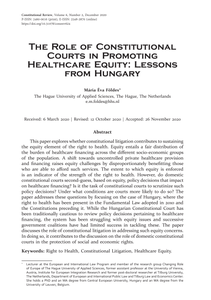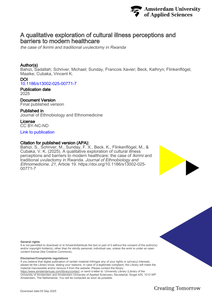This paper explores whether constitutional litigation contributes to sustaining the equity element of the right to health. Equity entails a fair distribution of the burden of healthcare financing across the different socio-economic groups of the population. A shift towards uncontrolled private healthcare provision and financing raises equity challenges by disproportionately benefitting those who are able to afford such services. The extent to which equity is enforced is an indicator of the strength of the right to health. However, do domestic constitutional courts second-guess, based on equity, policy decisions that impact on healthcare financing? Is it the task of constitutional courts to scrutinize such policy decisions? Under what conditions are courts more likely to do so? The paper addresses these questions by focusing on the case of Hungary, where the right to health has been present in the Fundamental Law adopted in 2010 and the Constitutions preceding it. While the Hungarian Constitutional Court has been traditionally cautious to review policy decisions pertaining to healthcare financing, the system has been struggling with equity issues and successive government coalitions have had limited success in tackling these. The paper discusses the role of constitutional litigation in addressing such equity concerns. In doing so, it contributes to the discussion on the role of domestic constitutional courts in the protection of social and economic rights.
MULTIFILE

Background: Inequities in health have garnered international attention and are now addressed in Sustainable Development Goal 3 (SDG3), which seeks to ‘promote well-being for all’. To attain this goal globally requires innovative approaches, one of which is twinning. According to the International Confederation of Midwives, twinning focusses on empowering professionals, who can subsequently be change-agents for their communities. However, twinning in healthcare is relatively new and because the definition and understanding of twinning lacks clarity, rigorous monitoring and evaluation are rare. A clear definition of twinning is essential for the development of a scientific base for this promising form of collaboration. Method: We conducted a Concept Analysis (CA) of twinning in healthcare using Morse’s method. A qualitative study of the broad literature was performed, including scientific papers, manuals, project reports, and websites. We identified relevant papers through a systematic search using scientific databases, backtracking of references, and experts in the field. Results: We found nineteen papers on twinning in healthcare. This included twelve peer reviewed research papers, four manuals on twinning, two project reports, and one website. Seven of these papers offered no definition of twinning. In the other twelve papers definitions varied. Our CA of the literature resulted in four main attributes of twinning in healthcare. First, and most frequently mentioned, was reciprocity. The other three attributes were that twinning: 2) entails the building of personal relationships, 3) is dynamic process, 4) is between two named organisations across different cultures. The literature also indicated that these four attributes, and especially reciprocity, can have an empowering effect on healthcare professionals. Conclusions: Based on these four attributes we developed the following operational definition: Twinning is a crosscultural, reciprocal process where two groups of people work together to achieve joint goals. A greater understanding and a mature definition of twinning results in clear expectations for participants and thus more effective twinning. This can be the starting point for new collaborations and for further international studies on the effect of twinning in healthcare.
MULTIFILE

BackgroundUnderstanding cultural perceptions of illness is crucial for effective healthcare delivery. This study examines the ethnomedical concept of ikirimi, a culturally recognized illness in Rwanda characterized by perceived uvula abnormalities, and its traditional management through uvulectomy. This study explores the cultural understanding of ikirimi, its perceived causes, symptoms, and treatments, as well as barriers to integrating modern healthcare.MethodsAn exploratory qualitative approach was employed, involving in-depth semi-structured interviews with eight participants: traditional healers, individuals who underwent traditional uvulectomy, and healthcare providers. A grounded theory approach which analyzes data in systematic manner to generate new theories was applied, with coding conducted in English after initial transcription and analysis in Ikinyarwanda to preserve Indigenous concepts.ResultsParticipants described ikirimi as an illness affecting the uvula (named as akamironko or akamirabugari or agashondabugari in Ikinyarwanda), characterized by swelling, elongation, and pus-like discoloration. Reported symptoms included fever, difficulty swallowing, coughing, and weakness, with children identified as the most affected group. Traditional healers diagnosed ikirimi through visual inspection of uvular morphology and movement and treated it by cutting the affected part of uvula and is known as guca Ikirimi ‘traditional uvulectomy’. Barriers to integrating modern healthcare included skepticism about biomedical care, judgmental attitudes from providers, and communication gaps. Despite the prevalence of ikirimi, its biomedical correlates remain unclear, though participants associated it with severe throat illnesses such as tonsillopharyngitis.ConclusionThe findings highlight ikirimi as a socially constructed illness with deep cultural roots, significant health implications, and persistent barriers to modern healthcare. Addressing these barriers requires culturally sensitive approaches that integrate Indigenous knowledge with biomedical practices. Future research should explore the biomedical correlates of ikirimi and foster collaboration between traditional and modern healthcare systems to improve patient outcomes.
DOCUMENT
